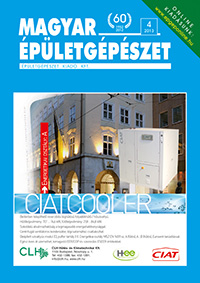Lapszámok

2013 10. szám
- Dr. Magyar Zoltán PhD - Hégli Mihály - Németh Gábor:
Az egészségügyi létesítmények mesterséges levegőellátására vonatkozó műszaki követelmények vizsgálata - Dr. Csoknyai István - Dr. Csoknyai Tamás PhD:
A fokozott hőszigetelésű épületek fűtési határhőmérsékletének és hőfokhídjának alakulása tényleges fogyasztási adatok alapján - Dr. Herczeg Levente - Érces Norbert:
Az atmoszférikus ionok hatása a komfortterekben tartózkodó emberek közérzetére - Király Tamás:
Új hővisszanyerős megoldások az Aereco Légtechnika Kft. kínálatában - Panasonic Marketing Europe GmbH South-East Europe Branch Office:
A PANASONIC ÚJ MF2-es 3 vezetékes hővisszanyerős ECOi VRF rendszere egyidejű hűtésre és fűtésre - Strulik Zrt.:
Strulik - Légtechnika, tűzvédelem magas fokon - Benkő Gábor:
Energiahatékony szellőztetés – Természetes és Hibrid rendszerek - Dr. Takács János PhD - Rácz, Lukáš:
Reconstruction of the District Heating Network from the Perspective of Investor and Operator - Daikin Hungary Kft.:
A legújabb technológia… Daikin „Csere” VRV® IV - Andrásy Zsolt:
Vízkezelések az épületgépészetben, 3. rész - Győző Miklós:
Geotermikus osztó-gyűjtő aknák javasolt kialakítása és lehetséges hibái - ENSI Kft.:
Kivitelezés alatt az új Fradi-stadion - Rébay Lajos:
Tanulságos életpályák – Dr. Morlin András
Hozzászólások
Reconstruction of the District Heating Network from the Perspective of Investor and Operator
Még nem érkezett hozzászólás!
Dr. Takács János PhD - Rácz, Lukáš
Reconstruction of the District Heating Network from the Perspective of Investor and Operator
The hydraulics of a thermal network of a district heating system is a very important issue, to which not enough attention is often paid.
In this paper the authors want to point out some of the important aspects of the design and operation of thermal networks in district heating systems.
The design boundary conditions of a heat distribution network and the requirements on active pressure – circulation pump – influencing the operation costs of the centralized district heating system as a whole, are analyzed in detail.
The heat generators and the heat exchange stations are designed according to the design heat loads after thermal insulation, and modern boiler units are installed in the heating plant.
The heat for the district heating (DH) supply system is generated by a hot water heating plant with the design temperature gradient of 130/70 °C.
Two circulation pumps are installed to assure circulation of the heat carrierwithin the network, connected in parallel, when the second pump presents a 100% backup in case of failure.
Outlet pipes of hot water boilers are connected with a hot water manifold. From the manifold pipes are connected to the heat distribution net, led under the ground.
Through the insulated distribution pipes the heat carrier flows to pressure independent heat exchanger stations (HES 1 to HES 5).Ascheme of the network is shown in Figure 1. The heat is transferred to the objects through a compact heat exchange station equipped with plate heat exchangers. The heat from the heat carrier (hot water with a temperature of 130/70°C) is transferred through the heat exchange surface in the plate heat exchanger to the heating network, as well as to the domestic hot water network in buildings. The secondary hot water heating networks have the temperature gradient of 80/60 °C or alternatively 75/55 °C, depending on the physical condition of each respective apartment building.
The heating networks are designed based on hydraulic equations for hot water networks and the pressure losses consist of the friction pressure losses in pipes and the losses due to local resistances (twists, reductions, branches and closing valves).










